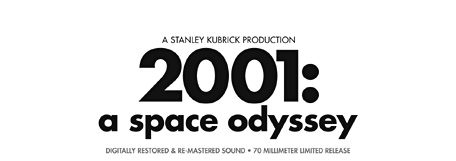"2001: A SPACE ODYSSEY" Production Information |
Read more at in70mm.com The 70mm Newsletter |
| Written by: Warner Brothers, press 2001. Retyped for in70mm.com by: Anders M. Olsson (Sweden) | Date: 13.02.2014 |
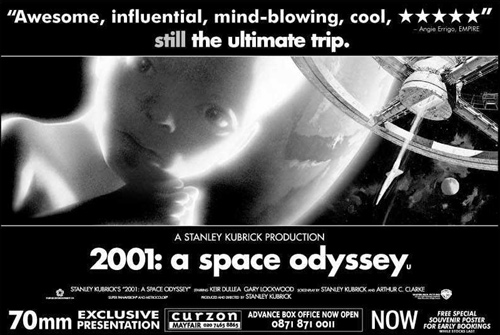 In the mid-20th century, seeing the future was
a dream shared by scientists and artists alike. In 1968, filmmaker Stanley
Kubrick brought that dream to life with the release of his visionary fable,
"2001: A Space Odyssey." In the mid-20th century, seeing the future was
a dream shared by scientists and artists alike. In 1968, filmmaker Stanley
Kubrick brought that dream to life with the release of his visionary fable,
"2001: A Space Odyssey."A film about the nature of man and machine, evolution and eternity, set against the inconceivable scope of the universe, "2001: A Space Odyssey" has mesmerized generations of audiences and been called one of the most influential films of all time. In 1968, "2001" was ahead of its time. Now, its time has come. Nominated for four Academy Awards, including Best Director and Screenplay, the film took home an Oscar for its stunning visual effects and claimed three BAFTA Awards for Art Direction, Cinematography and Sound, as well as a Hugo Award for Best Dramatic Presentation. Directed and produced by Stanley Kubrick from a screenplay by Kubrick and renowned science fiction writer Arthur C. Clarke, "2001: A Space Odyssey" stars Keir Dullea and Gary Lockwood. The director of photography is Geoffrey Unsworth; production designers are Tony Masters, Harry Lange and Ernie Archer; and the editor is Ray Lovejoy. The film is distributed by Warner Bros. Pictures, A Time Warner Entertainment Company. "2001: A Space Odyssey" tells the story of astronauts Dave Bowman (Dullea) and Frank Poole (Lockwood), aboard the spaceship Discovery, who are sent on an exploratory mission to a point near the outer reaches of the Solar System. The operation runs smoothly at first but then slowly, inexplicably, things begin to go wrong. The true nature of the mission is called into question and Discovery's highly sophisticated onboard computer, the HAL-9000, appears to be sabotaging the crew he was designed to assist, jeopardizing not only the mission but the lives of everyone onboard. What begins as one kind of adventure becomes an entirely different one that extends not only into the uncharted realms of space but into the nature of life itself. |
More in 70mm reading: "2OO1: A Space Odyssey" in Super Panavision 70, Cinerama and 6-track Stereo Sound The Original Reserved Seat Engagements Of ‘2001: A Space Odyssey’ Full credits for "2001:A Space Odyssey" 2001: a space odyssey Campaign Douglas Trumbull - A Conversation Internet link: |
ABOUT THE PRODUCTION |
|
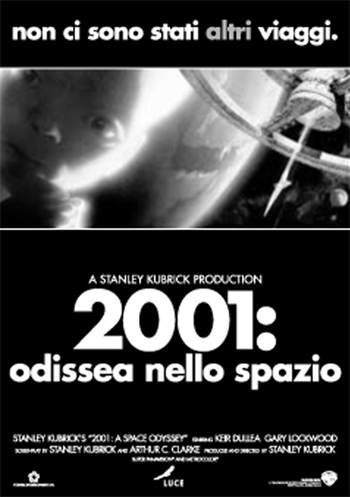 Roger Caras, the publicist for
"2001," cabled
Arthur C. Clarke at his home in Celyon, Sri Lanka: Roger Caras, the publicist for
"2001," cabled
Arthur C. Clarke at his home in Celyon, Sri Lanka:"STANLEY KUBRICK - DR. STRANGELOVE, PATHS OF GLORY, ET CETERA, INTERESTED IN DOING FILM ON ET'S. INTERESTED IN YOU. ARE YOU INTERESTED? THOUGHT YOU WERE A RECLUSE." Clarke immediately cabled back: "FRIGHTFULLY INTERESTED IN WORKING WITH ENFANT TERRIBLE STOP CONTACT MY AGENT STOP WHAT MAKES KUBRICK THINK I'M A RECLUSE?" Stanley Kubrick and Arthur C. Clarke met for the first time in New York City, April 22, 1964, at Trader Vic's. Kubrick came with the idea of making a movie about Man's relationship to the universe. It had been brewing in his mind for some time and he was determined to create a film that would provoke emotions of wonder, awe, even terror, in his audience -- something that had never before been attempted. Clarke, who was highly trained as a scientist and one of the foremost science-fiction writers in the world, was Kubrick's only option. Clarke agreed and, though their working relationship would prove to be notoriously tumultuous, they had each found the perfect partner with whom each could second-guess the future. Although Clarke and Kubrick remained friends after the completion of "2001," in Clarke's book, The Lost Worlds of 2001, he described his working relationship with Kubrick in equal parts deeply rewarding and maddening: "He would build up my morale (which often needed it) by unstinted praise of some piece of writing I'd just produced; then in the course of the next few days, he would find more and more flaws until the whole thing was slowly whittled away. This was all part of his ceaseless search for perfection, which often provoked me to remind him of the aphorism, 'No work of art is ever finished; it is only abandoned....But I admired him for his tenacity, even when I wished it wasn't focused on me." Kubrick began by pointing out to Clarke that most movies at that time were adapted from already existing novels and usually ones that had been best-sellers with a built-in box-office guarantee. And it was his unorthodox suggestion that, before they embark on the drudgery of writing a script, they allow their imaginations to soar freely by developing their story in the form of a complete novel first. Kubrick deeply felt that the screenplay form was the least ideal way of communicating visual and emotional information. Clarke agreed and allowed Kubrick to option his short story, "The Sentinel," that they would use as a point of departure. In theory, the novel would be written with an eye for the screen, and the script would then be derived from the novel. In practice Clarke reported that the result was far more complex: "Toward the end both novel and screenplay were being written simultaneously, with feedback in both directions. Some parts of the novel had their final revisions after they had seen the rushes based on the screenplay, based on earlier versions of the novel...and so on." It took two years to transform "The Sentinel" into a complete novel. At one point Kubrick speculated that he and Clarke had put in an average of four hours a day, six days a week on the writing of the script. (This works out to about 2,400 hours of writing for one hour and forty-one minutes of screen time.) Even during the actual shooting of the film, Kubrick spent much of his free time examining the story (while holed up in a blue trailer once used as a dressing room for Deborah Kerr, which he would have wheeled onto the set.) Kubrick's eye for detail and accuracy was unerring. During the writing process Kubrick read every popular book on the subject of space travel and dragged Clarke to see every science-fiction film available to them, comparing plot lines and scrutinizing special effects. No stone was left unturned in any aspect of production. During the making of "2001", when Kubrick decided to keep track of his ideas in small notebooks, he ordered a sample sheet of every type of notebook paper made by a prominent paper firm - about a hundred varieties to choose from in all. The initial schedule was optimistic: 12 weeks to write the script, 2 weeks to discuss it, 4 weeks to revise it, 4 weeks to fix the deal, 4 weeks for visuals effects and art direction development, 20 weeks to shoot and 20 weeks to edit. Allowing another 12 weeks before release, this would add up to the better part of two years. The project's ultimate duration was four years. The original title in the 1965 press release was "JOURNEY BEYOND THE STARS" with the goal of a 1966 release. Little did Kubrick and MGM (the studio behind the production) know that Ed White would become the first American to walk in space on June 3, 1965; The Mariner IV would travel within 6200 miles of Mars and send 22 photos back to earth on June 14; and that Kubrick himself would contact Lloyds of London to price an insurance policy against Martians being discovered before the release of his film in 1968. |
|
Pre-Production |
|
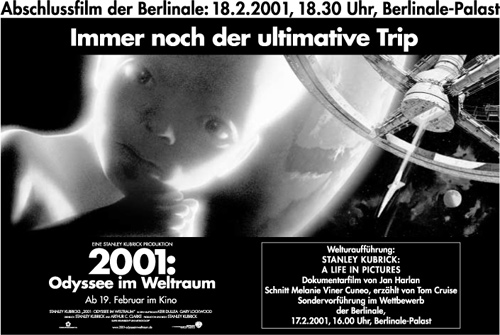 "There is nothing we wanted to do we couldn't
do or wouldn't do. Stanley would say, 'If you can describe it, I can film
it.'" - Arthur C. Clarke, in Newsweek. "There is nothing we wanted to do we couldn't
do or wouldn't do. Stanley would say, 'If you can describe it, I can film
it.'" - Arthur C. Clarke, in Newsweek.As soon as the story began to take shape, it was time for Kubrick to think about how he was visually going to pull this off. Nobody really knew for sure what space vehicles would look like or operate in 2001 and Kubrick would not rest until he had absolute realism. His goal was to do everything possible to make each scene completely authentic and to make it conform to what was known to physicists and astronomers at that time. Toward the end of January 1965, a small group of prominent space writers, scientists and researchers all happened to be in New York City at the same time. Two of them were Harry HK Lange and Frederick Ordway. Lange had previously been on NASA's staff, working on space vehicle concepts; Lange was a superb draughtsman and colorist, familiar with the most highly classified details of propulsion systems, radar navigation and docking techniques. His job at NASA had been to literally try to visualize unborn vehicle concepts, so that NASA could communicate their ideas for the future. Ordway was, not only a leading intellectual at NASA, but also had a gift for public relations. Over drinks at the Harvard Club with Lange and Ordway, Clarke told his NASA friends all about the young and talented director Stanley Kubrick with whom he was working on a project they were hoping would become the definitive space movie, against which all others of its kind would be judged - portraying the enormity of humanity facing the enormity of the cosmos. What a coincidence, they told Clarke. It seemed they were putting together a book on the same subject. Before Lange and Ordway could get a cab outside of the Harvard Club, one of the club's employees told Ordway that he had a phone call inside. It was Kubrick, making him and Lange an offer to come work on "2001." Ordway would become the principal technical advisor and Lange would, along with Tony Masters, become the film's Production Designer, building visionary sets on which cinematic history would be made. 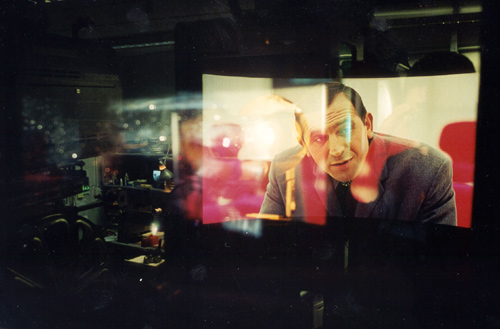 Ordway proceeded to enlist the help of NASA, IBM, Boeing, Bell Telephone and
Grumman to name only a few major corporations that availed themselves to
provide endless amounts of documentation and research. This would only
attempt to quell Kubrick's insatiable appetite for detail. Kubrick
questioned everything: What kind of fuel would an interplanetary spaceship
use? How big would its radio dish be? How would the astronauts eat and
sleep? What kind of pajamas would they wear? All corporations involved were
pleased with the outcome of the film with the exception of IBM, when a
cryptographer discovered that the IBM letters were just one notch along the
alphabet from HAL - the murderous brain of the space ship. Incidentally,
HAL's violent episode is the only conventional dramatic element in the
entire film. Ordway proceeded to enlist the help of NASA, IBM, Boeing, Bell Telephone and
Grumman to name only a few major corporations that availed themselves to
provide endless amounts of documentation and research. This would only
attempt to quell Kubrick's insatiable appetite for detail. Kubrick
questioned everything: What kind of fuel would an interplanetary spaceship
use? How big would its radio dish be? How would the astronauts eat and
sleep? What kind of pajamas would they wear? All corporations involved were
pleased with the outcome of the film with the exception of IBM, when a
cryptographer discovered that the IBM letters were just one notch along the
alphabet from HAL - the murderous brain of the space ship. Incidentally,
HAL's violent episode is the only conventional dramatic element in the
entire film.Following a stint in New York City's Central Park West, the production moved to the spacious sound stages of Borehamwood, North London. Twenty heavy truckloads of data had been shipped via the S.S. France filled with research materials, to meet up with the special effects team -- Wally Veevers, Con Pederson and MGM's in-house expert, Tom Howard. Tony Masters supervised the impressive interior sets as Harry Lange translated his ideas into models that could be convincingly photographed. Much of what the "2001" team came up with was based on pure speculation, using current realities as a point of departure. Animated discussions took place about the realism or relevance of a particular design; even Kubrick, who was a stickler for authenticity, was occasionally heard reminding his overheated experts that this was only a movie. At the height of its construction, 103 model makers were employed on various projects aimed at creating the space vehicle The Discovery. Among the staff were boat builders, architectural students, fine artists, sculptors, lithographers and metal workers. Kubrick was fond of calling their realm "Santa's Workshop," but employee turnover was high as many of them failed to satisfy the exacting demands of the production principals. The "2001" staff continued to work in a vacuum while, in a parallel universe to its own, NASA was trying this stuff out for real. In the mid-1960s, Cape Kennedy was struggling to put capsules weighing only a few tons into low earth orbit while Kubrick was demanding to know how to keep a crew alive in Jupiter's orbit in the next century. And also like their friends at NASA, many became so absorbed by their work that things like Vietnam, Martin Luther King Jr. and the Counter Culture were abstract ideas and people. Indeed, it was NASA's high ranking George Mueller who dubbed the "2001" soundstage "NASA East." Kubrick believed that if "2001" was to be credible on a technical level, no detail was too small to consider. The same care for detail was given to the ape costumes, which he felt were equally important, as he had never seen them portrayed convincingly. For his apes, the body problem was solved by employing dancers with extremely narrow hips that would not bulk up the hairy suits, and the head problem was solved by making an intricate headpiece equipped with little toggle switches that the actors could work with their tongues. For the film's infamous mysterious black monolith that appears at every new destination, chunks of rock were cut, polished and photographed - only to end up looking like chunks of polished rock. That extra something was missing. Finally they settled on using a wooden monolith that was then painted with a combination of paint and pencil graphite, then rubbed down and painted again, until the slab glowed with the dark resonance seen in the film. Touching the monolith became known as a capitol offense on the set. Between scenes, layers and layers of cotton and plastic sheeting protected it. |
|
Production and Special Effects |
|
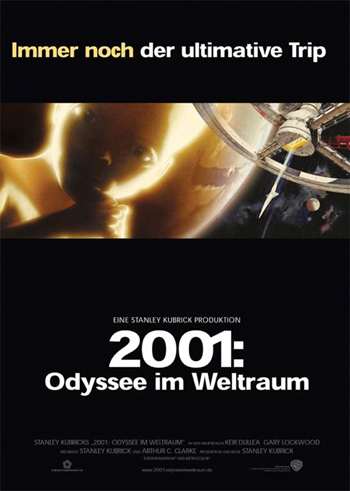 Without the luxury of computer technology,
Kubrick stretched his imagination and those of his colleagues to attain the
reality in film that he sought. This resulted in groundbreaking techniques
that changed the film industry and the concept of science-fiction films, and
virtually paved the way for some of the film technology we use today. Without the luxury of computer technology,
Kubrick stretched his imagination and those of his colleagues to attain the
reality in film that he sought. This resulted in groundbreaking techniques
that changed the film industry and the concept of science-fiction films, and
virtually paved the way for some of the film technology we use today.For the "Dawn of Man" sequence, in which ape-like pre-humans are seen in action against a natural-looking background, Kubrick and his team used the front-projection system on a scale never before attempted, making it economically feasible to film large-scale epics on a soundstage without the expense of going on location. Painstaking effort went into the groundbreaking effects that enabled the film's "single generation look" - in which complex scenes have an unusually sharp, crisp and grain-free appearance to them - an aesthetic we take for granted in our present computerized post-production world. Another incredible and innovative feat was in the design and building of the actual space ship Discovery. In 1965, many spacecraft designers agreed on the notion that, while weightlessness had a certain amusement and mystique to it, most likely by 2001 some sort of artificial gravity would be supplied for space travelers. Having accepted this, Kubrick hired The Vickers Engineering Group to build a real 40-foot in diameter, ferris wheel-shaped centrifuge in which he could create the illusion of weightlessness at a total cost of $750,000. The mammoth set rotated at three miles-per-hour and was equipped with a closed-circuit TV system, enabling Kubrick to direct filming from outside the wheel. According to "2001" Special Effects Supervisor Douglas Trumbull, one of the more serious problems to have plagued the production was simply keeping track of all of the various ideas, shots and changes constantly coming through. To handle the information overload, a "control room" was set up to contain the stacks of papers, flow charts, diagrams, log sheets and punch cards generated by the production. A staff of several people was kept on to man the room at all times. With a half-dozen cameras shooting simultaneously, some on 24-hour shifts, and different aspects of many sequences being executed at once, the problem of keeping on top of every action was difficult at best. All scenes were numbered, slowly evolving into a system of names for football plays. For example, all scenes in the Jupiter sequence were jokingly referred to as "deep pass," "kick-off" and "punt-return." The final product was the most realistic space film ever made. By any standards, 2001 still looks convincing today. Unlike most films of its time, special effects and production values took precedence over casting and movie-star value. Because the characters of the astronauts present in the film are basically there to facilitate the much bigger picture, Kubrick purposefully cast actors that would not eclipse the film's larger themes. The two principal leads chosen to pull off the film's total of 25 minutes of dialogue were Keir Dullea and Gary Lockwood. For the voice of HAL - the computer that undergoes a strange and dangerous transformation aboard the Discovery -- Kubrick originally hired an English actor but eventually went with an American one, Douglas Rain. By January of 1967, Kubrick was ready to find the perfect score to fit best in his space masterpiece. Having claimed to listen to almost every modern composition available on record, he wanted something unusual and distinctive, yet not distracting. Kubrick then brought in the film composer, Alex North, asking him to come up with something close to the temporary tracks of Strauss's "Blue Danube" and Mendelssohn's Scherzo from "Midsummer Night's Dream." At first North thought it was a dream job - writing a score for a film with less than a half-hour of dialogue and no sound effects! After working day and night to meet Kubrick's deadline, North finally made it to a screening in New York, only to find that Kubrick had returned to his "temp tracks" without telling him. By the end of production Kubrick had pulled off his vision. As Herb A. Lightman once wrote for American Cinematographer, "In its larger dimension, this production may be regarded as a prime example of the auteur approach to filmmaking - a concept in which a single creative artist is, in the fullest sense of the word, the author of the film." |
|
The Aftermath |
|
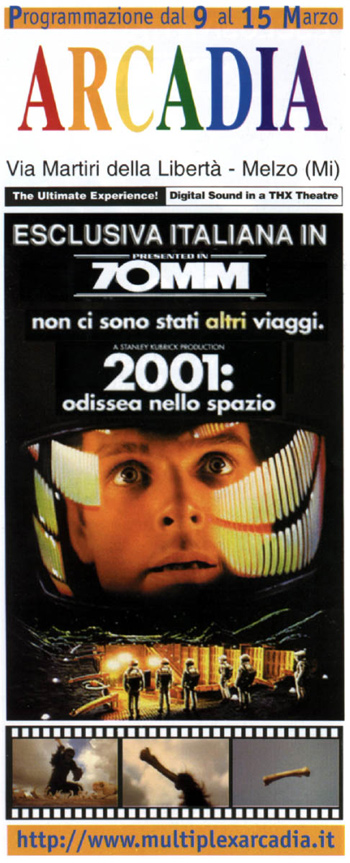 "What we are trying to create is a realistic
myth - and we may have to wait until the year 2001 itself to see how
successful we have been." - Arthur C. Clarke "What we are trying to create is a realistic
myth - and we may have to wait until the year 2001 itself to see how
successful we have been." - Arthur C. ClarkeThe first public screening of "2001: A Space Odyssey" at the Capitol Theatre on Broadway was a disaster. The audience laughed at the apes during the "Moon Watcher" scene and left in disappointment, bewilderment and sometimes disgust during the final Star Gate sequence. It was uniformly shredded by the critics and Kubrick's directorial efforts were lambasted. Critics called him a grandiose filmmaker, totally absorbed in his own principles. But Kubrick would fight back. After shutting himself in for a few days, Kubrick listened to the feedback and took to the editing room. In no time he had cut out an additional 17 minutes from the print that was originally shown. When the film opened in limited release around the world, it was necessary for Kubrick to hire and dispatch film editors to all the various cities so they could make the new edits in the prints while Kubrick stayed back to reconform the negative. The film then opened to steady box-office receipts that increased soon after. Film critics revisited the film and re-assessed. Reviews were mixed and Kubrick was called everything from "pretentious" to "a genius." Kubrick once told his good friend, the author Alexander Walker, "It's not a forecast, it's a fable." When pressed to speak about his intentions behind "2001" Kubrick steadfastly maintained that he would not interpret this movie for the press or for his audience - that he had "tried to create a visual experience, one that bypasses verbalized pigeonholing and directly penetrates the subconscious with an emotional and philosophical content." He continued, "I think that if '2001' succeeds at all, it is in reaching a wide spectrum of people who would not often give a thought to man's destiny, his role in the cosmos and his relationship to higher forms of life." Clarke, on the other hand, was disturbed by the drug culture's enthusiastic embracing of the film. In an interview with the Free Press, Clarke told them, "I get very annoyed. I was at a science-fiction convention last week and some well-wisher thrust a packet of LSD in my hands, in gratitude, I suppose, assuming that I'd used it for '2001' and needed some more for my next project." In April 1969, "2001: A Space Odyssey" received an Oscar for Special Effects and three British Film Academy Awards for cinematography, art direction and soundtrack, and Stanley Kubrick went on to start thinking about his next project - perhaps a film about Napolean or developing a short story of Arthur Schnitzel (which would become "Eyes Wide Shut"). Ray Bradbury once said it well: "Why do we go back to see '2001' over and over and over ... We return to it because the very possibility of its interpretations frees us to carom off into the greatest of all architecture: the universe itself." |
|
|
|
|
|
ET#1 THIS FILM WAS DIRECTED AND PRODUCED BY STANLEY KUBRICK ET#2 SCREENPLAY BY STANLEY KUBRICK AND ARTHUR C. CLARKE ET#3 PRESENTED BY METRO-GOLDWYN-MAYER ET#4 IN (logo) ® CINERAMA ET#5 STARRING KEIR DULLEA ET#6 STARRING GARY LOCKWOOD ET#7 STARRING WILLIAM SYLVESTER DANIEL RICHTER ET#8 FEATURING LEONARD ROSSITER MARGARET TYZACK ROBERT BEATTY SEAN SULLIVAN DOUGLAS RAIN ET#9 WITH FRANK MILLER BILL WESTON EDWARD BISHOP GLENN BECK ALAN GIFFORD ANN GILLIS EDWINA CARROLL PENNY BRAHMS HEATHER DOWNHAM MIKE LOVELL ET#10 WITH JOHN ASHLEY PETER DELMAR DAVID HINES DARRYL PAES JIMMY BELL TERRY DUGGAN TONY JACKSON JOE REFALO DAVID CHARKHAM DAVID FLEETWOOD JOHN JORDAN ANDY WALLACE SIMON DAVIS DANNY GROVER SCOTT MACKEE BOB WILYMAN JONATHAN DAW BRIAN HAWLEY LAURENCE MARCHANT RICHARD WOOD ET#11 SPECIAL PHOTOGRAPHIC EFFECTS DESIGNED AND DIRECTED BY STANLEY KUBRICK ET#12 SPECIAL PHOTOGRAPHIC EFFECTS SUPERVISOR WALLY VEEVERS ET#13 SPECIAL PHOTOGRAPHIC EFFECTS SUPERVISOR DOUGLAS TRUMBULL ET#14 SPECIAL PHOTOGRAPHIC EFFECTS SUPERVISOR CON PEDERSON ET#15 SPECIAL PHOTOGRAPHIC EFFECTS SUPERVISOR TOM HOWARD ET#16 PRODUCTION DESIGNED BY TONY MASTERS HARRY LANGE ERNEST ARCHER ET#17 FILM EDITOR RAY LOVEJOY ET#18 WARDROBE BY HARDY AMIES ET#19 DIRECTOR OF PHOTOGRAPHY GEOFFREY UNSWORTH B.S.C. ET#20 ADDITIONAL PHOTOGRAPHY JOHN ALCOTT ET#21 MUSIC BY ARAM KHATCHATURIAN GAYANEH BALLET SUITE Performed by the Leningrad Philharmonic Orchestra Conductor Gennadi Rozhdestvensky Courtesy Deutsche Grammophon ET#22 MUSIC BY GYÖRGY LIGETI ATMOSPHERES Performed by the Southwest German Radio Orchestra Conductor Ernest Bour LUX AETERNA Performed by the Stuttgart Schola Cantorum Conductor Clytus Gottwald REQUIEM Performed by the Bavarian Radio Orchestra Conductor Francis Travis ET#23 MUSIC BY JOHANN STRAUSS THE BLUE DANUBE Performed by the Berlin Philharmonic Orchestra Conductor Herbert von Karajan Courtesy Deutsche Grammophon ET#24 MUSIC BY RICHARD STRAUSS THUS SPOKE ZARATHUSTRA ET#25 FIRST ASSISTANT DIRECTOR DEREK CRACKNELL ET#26 SPECIAL PHOTOGRAPHIC EFFECTS UNIT COLIN J. CANTWELL BRUCE LOGAN BRYAN LOFTUS DAVID OSBORNE FREDERICK MARTIN JOHN JACK MALICK IN TECHNICOLOR® AND METROCOLOR THE EVENTS, CHARACTERS AND FIRMS DEPICTED IN THIS PHOTOPLAY ARE FICTITIOUS. ANY SIMILARITY TO ACTUAL PERSONS, LIVING OR DEAD, OR TO ACTUAL FIRMS, IS PURELY COINCIDENTAL. APPROVED NO. 21197 (mpaa emblem) MOTION PICTURE ASSOCIATION OF AMERICA MGM (logo) A METRO-GOLDWYN-MAYER PRODUCTION MT#27 CAMERA OPERATOR KELVIN PIKE ART DIRECTOR JOHN HOESLI SOUND EDITOR WINSTON RYDER MAKE-UP STUART FREEBORN EDITORIAL ASSISTANT DAVID DE WILDE SOUND SUPERVISOR A.W. WATKINS SOUND MIXER H.L. BIRD CHIEF DUBBING MIXER J.B. SMITH SCIENTIFIC CONSULTANT FREDERICK I. ORDWAY III MT#28 FILMED IN SUPER PANAVISION® MT#29 MADE AT MGM BRITISH STUDIOS LTD. BOREHAMWOOD, ENGLAND MT#30 THE END |
|
| Go: back - top - back issues - news index Updated 22-01-25 |

